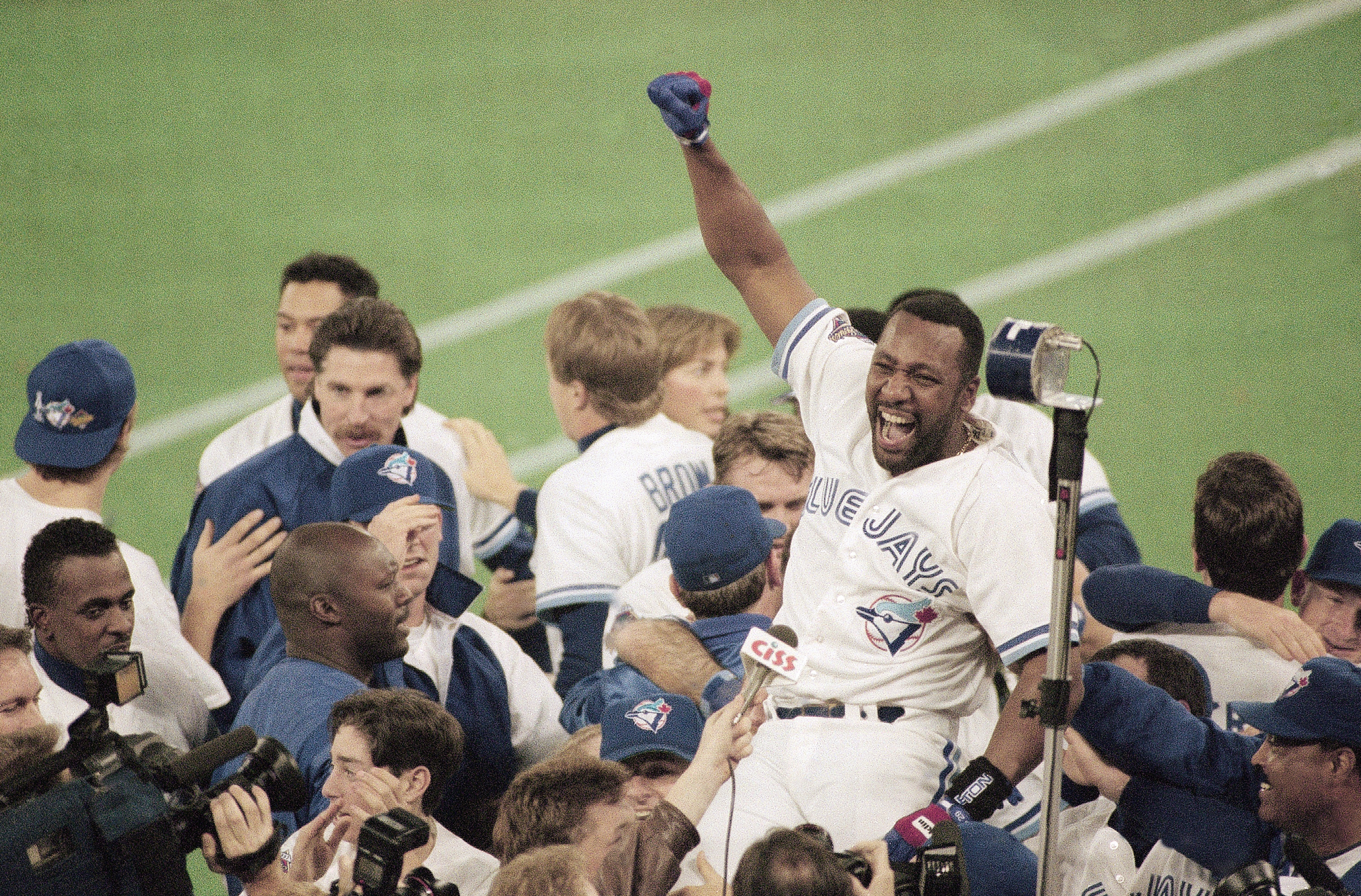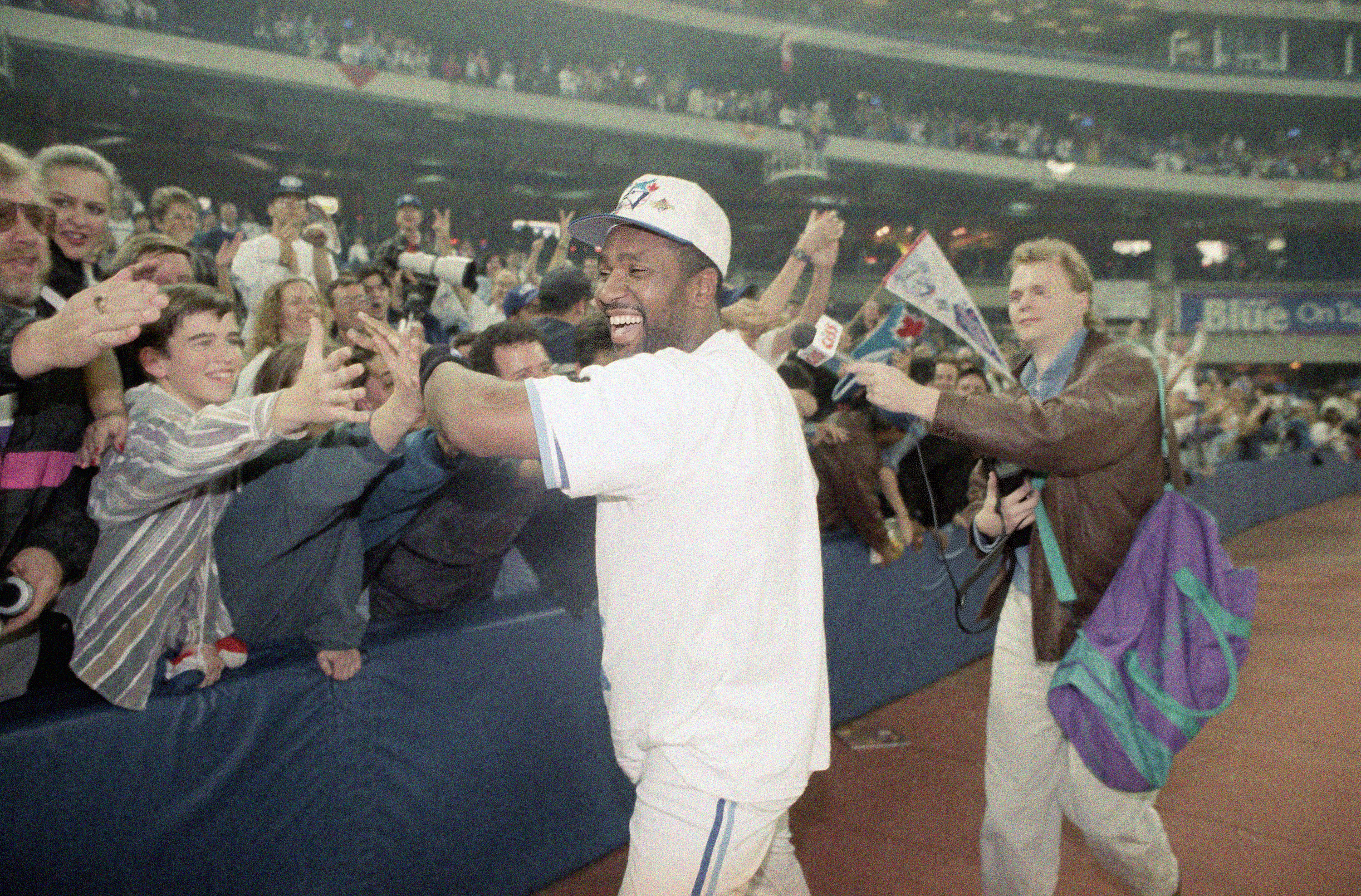A version of this story ran in October 2023.
It was Oct. 23, 1993. Bottom of the ninth, Game 6 of the World Series between the Philadelphia Phillies and the defending World Series champion Toronto Blue Jays. Phillies closer Mitch Williams on the mound, trying to protect a 6-5 lead and force a decisive Game 7. A walk to Rickey Henderson and a hit by Paul Molitor, sandwiched around a flyout by Devon White, left runners on first and second with one out.
Joe Carter strode to the plate. He took the first two pitches -- both balls -- to get ahead in the count. Carter took the third pitch right down the middle for strike one, then swung through a pitch to even the count at 2-2.
He now was looking for a breaking ball, but Williams threw a fastball, down and in, and the rest is history. Carter turned on it, lining a Series-winning home run over the left-field fence.
“To see the ball go over the fence -- right now, just talking about it -- I still get chills, because it brings back that whole feeling of what it was like when the SkyDome erupted,” Carter said. “When you see your teammates react in that way, it gives you great joy. You always want to come through for the man in front of you and behind you.”
After the Series, Williams didn’t regret throwing a fastball, but did regret his approach. And, of course, the location of the pitch.
“The only thing I ever regret in that Series is that I didn’t throw the ball in a full motion. I threw it from a slide step,” Williams said in the documentary, ‘High Hopes: The story of the 1993 Phillies.’
“Needless to say, I don’t have trouble getting the ball up and away,” Williams said. “That’s where that pitch was supposed to be. I jerked it down and in to one of the few right-handed hitters you don’t miss down and in. … That was my only regret.”
Carter’s home run was just the second to end a World Series -- the first, of course, was Bill Mazeroski’s Game 7 winner in 1960 -- the same year Carter was born -- against the Yankees. But it was the first time, and still the only time, a player hit a walk-off home run while trailing in the bottom of the ninth inning to win a World Series. Mazeroski’s home run came when the score was tied.
“Time flies when you get older,” Carter said. “It seems like a moment ago. ... You can’t fathom it happening 30 years ago. But every time I get up, I think about how old I am. I’m 63 years old and yeah, it has been 30 years. But it’s a great moment to have that memory.”
As Carter was circling the bases, the excitement of Tom Cheeks, the legendary play-by-play voice of the Blue Jays, said it all: “Touch ’em all, Joe. You’ll never hit a bigger home run in your life.”
He wasn’t wrong. Carter would play five more seasons in the big leagues and never hit another dramatic tater like the one in ’93. “I felt the same way Tom felt,” Carter said. “How many people hit a home run to end the World Series? That’s only happened twice now. Tom was correct. That is true to this day. I can go back and look at a lot of home runs, but there were none bigger because of the impact it had to win the World Series. Back-to-back champs. Yeah, it was pretty phenomenal.”

Ironically, it marked the second consecutive year that Carter was involved in the final play of the Fall Classic. The previous year, Carter was playing first base and caught the last out. Braves outfielder Otis Nixon had tried to bunt his way on, but right-hander Mike Timlin quickly grabbed the ball and threw it to Carter to make the Blue Jays the first Canadian team to win a World Series title. For Carter, he can’t believe that the World Series ended on a home run only twice in its history.
“There are a lot of things that happened throughout the history of the game. But a home run in the bottom of the ninth to win a World Series, you think, ‘Why hasn’t it happened more than twice?’” Carter said. “Bill Mazeroski held that record for 33 years. Records are made to be broken, so I figured I have three more years to enjoy it.”
The people in Toronto will never let Carter forget the accomplishment whenever he has his annual golf tournament there or attends a Raptors game or a Blue Jays game. The acknowledgement is tremendous, he said. But Phillies fans won’t let Carter forget about the historic moment either. Recently, his daughter, Kia, called him to inform him that she was at the airport and noticed there was a Phillies fan wearing a T-shirt that read, “Joe Carter ruined my childhood.”
“She took a picture of it, and she showed it to me,” Carter recalled. “People have talked about it so much. I don’t think it’s really changed my life so much. I tell everybody that I hit more than one home run in my career. But they tend to focus on that one home run. I said, ‘Well, I guess that’s what you are going to be known for. That’s fine.’”
BLUE JAY WAY
Carter was a big part of the Blue Jays teams that won consecutive World Series titles in 1992-93. Carter doesn’t have to think twice about which was the better team: It was ’93, hands down. And it had nothing to do with his historical home run. As Carter puts it, the Blue Jays had an All-Star team. Seven of them, including Carter and Roberto Alomar, were on the American League roster in Baltimore. The Blue Jays had three players -- Molitor, Alomar and John Olerud -- in the top three in the AL batting race.
Yes, they lost several key players in Dave Winfield, David Cone and Tom Henke from the previous title run. But the team made up for the losses by adding Molitor, Henderson, Tony Fernandez and Dave Stewart. Toronto was even able to pluck talent out of its bullpen and turn Pat Hentgen into one of the top starters in the rotation. The Blue Jays had the best manager in their history in Cito Gaston, who became the first African American to win the World Series title the year before.
“The first place you have to look is the manager and coaching staff,” Stewart said. “Cito did a great job of letting guys just play the game. We had some good players. … Joe was right in the middle of it all. “When you look at Joe’s track record and history, quite frankly, he should be a Hall of Famer and, maybe that’s going to come at some point. When you look at it, Joe never left runners stranded at third base. If there was a runner on third base with one out or fewer, Joe was going to figure out how to get that runner in. He was just that guy.”
The Blue Jays clinched their fifth-ever American East title on Sept. 27, 1993, with a 2-0 victory over the Brewers. Toronto moved on to play the White Sox in the American League Championship Series, and the Blue Jays advanced to the World Series by beating Chicago in six games.
HERE COME THE PHILLIES
The 1993 Phillies were a team like no other. They were not business-like on and off the field. Maybe Phillies historian Larry Shenk said it best: “Along came a bunch that had more nicknames, mostly unflattering: throwbacks, misfits, rejects, outlaws, wild, crazy,” Shenk wrote for MLB.com. Those players included Williams, Lenny Dykstra, John Kruk and Darren Daulton. Yet, after a last-place finish the year before, Philadelphia surprised the baseball world by capturing the National League East title.
The Phillies upset the Braves in the NLCS, beating them in six games. Long before the legendary “Bloody Sock Game” with the Red Sox in 2004, Curt Schilling was the ace of the Phillies and NLCS MVP after allowing three earned runs and striking out 19 in 16 innings. What made those Fightin’ Phillies so good? Despite how they looked and acted off the field, they played the game the right way.
“Our team was amazing all year, with someone always coming up with a clutch hit to keep us going,” said outfielder Milt Thompson. “We were unselfish, and we just went out and played.”
THE WORLD SERIES AND A HERO NAMED CARTER
The Phillies were not pushovers by any means in the Fall Classic. In fact, it looked like they were going to tie the Series in Game 4. That game turned out to be a slugfest. Going into the eighth, Philadelphia had a 14-9 lead, but couldn’t close it out. To many, it was the turning point. Phillies reliever Larry Andersen started the inning, faced four hitters, but only recorded one out. It didn’t help that third baseman Dave Hollins’ error allowed a run to score.
Enter Williams. Manager Jim Fregosi was hoping that the left-hander would close out the game. Williams faced six hitters that inning and five more runs scored. The biggest blow came from Devon White, whose triple scored Pat Borders and Henderson to take a 15-14 lead.
“We never should have lost that game,” Thompson said. Before becoming a quality starter with the Marlins and Mets, left-hander Al Leiter was a reliever with Toronto. He pitched in Game 4 and was hit hard, allowing six runs in 2 2/3 innings. He called that game the pivotal point in that World Series.
“That was crazy in a way that it felt like a football score and was back and forth,” Leiter said. “[That eighth inning] flipped the script.”
But the Blue Jays couldn’t take the World Series trophy the next day because Schilling pitched a complete-game shutout in a 2-0 victory. And it appeared the Phillies were going to tie the Series two days later. Stewart started for Toronto and was cruising through the first six innings, allowing one run. But the veteran right-hander and the bullpen couldn’t hold a 5-1 lead.
Philadelphia ended up scoring five runs in the seventh to take the lead. Stewart faced three hitters in the seventh and all three reached safely. Dykstra had the biggest hit with a three-run homer. By the time the inning ended, two more runs scored and the Phillies held a one-run lead.
“It was disheartening, and you could hear the air come out of the Dome, but it was only a 6-5 ballgame,” Carter remembered. But never doubt that Blue Jays offense.
Yes, they were shut out in the bottom of the seventh and eighth innings. But the bottom of the ninth would have the top of the order come to the plate. Carter said if not for Toronto loading the bases the previous inning, he might never have had an at-bat in the ninth.
“It turned the lineup over -- we had Rickey Henderson leading off,” Carter said. “If that didn’t happen, we could have had seven, eight and nine coming up in the ninth.” Instead, it set the stage for Carter’s heroics. As he was circling the bases, Carter thought about doing cartwheels, but he didn’t want to hurt himself. It was a pile-on after Carter reached home plate. Then his teammates lifted him up as if he was king of the diamond.
“I don’t think we had the mindset of, ‘We’ll get them tomorrow,’” Leiter said. “Our length [in the batting order] was just too good with Rickey, Alomar, Olerud and Molitor. Three of them are Hall of Famers. … Joe was such an RBI machine. That’s why I don’t believe in or listen to or put much credence in the analytic community when they say the numbers don’t show that guys are better in RBI situations or not. Joe could be hitting .230 and you would want him up with runners on second and third and less than two outs.”

As the celebration started to subside, Mets public relations man Jay Horwitz, who worked for MLB in the same role during the World Series, approached Carter.
“I greeted him at home plate. I said, ‘Joe, I don’t want to be a pain in the [butt], but I need you to do some interviews right now,’” Horwitz recalled. “I saw him at an All-Star Game a couple years ago. He said, ‘Every picture in my house has you and me at home plate.’”
While Carter was the hero of the day, forgotten was that Molitor was the World Series MVP, hitting .458 with two homers and seven RBIs. According to Gaston, everybody on the team wanted to see Molitor get his first World Series ring.
“The talk around the clubhouse most of that year was that Paul was close to a ring with the Brewers in 1982. But the Blue Jays busted their [butts] and the thought was, ‘We want Paul to have one like we received last year.’ Paul went out there and he did his job, too.”
A few weeks after the game-winner, Carter’s hometown of Leawood, Kan., threw a parade in his honor. To Carter’s surprise, Hall of Famer Buck O’Neil was in attendance. O’Neil was the scout who signed Carter to his first professional contract with the Cubs back in 1981.
“We go to my daughter’s middle school and she introduced me. Lo and behold, who was there? Buck O’Neil,” Carter said. “They gave me a key to the city and Buck was right there. “It’s the people that put a lot of confidence in you. One thing Buck said to me was, ‘Young man, you have a lot of talent. You go out there and have fun playing the game. You enjoy the game.’ … I played every game just like that. When I saw him, it brought a smile to my face.”
